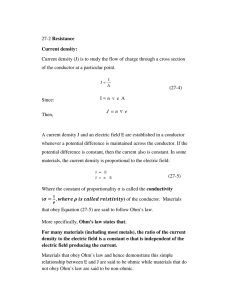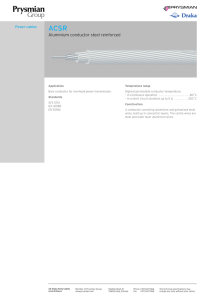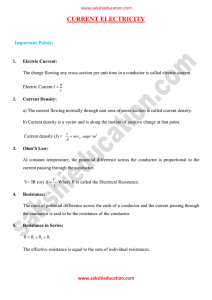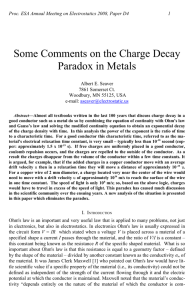Notes 18-01 Electric Currents
advertisement
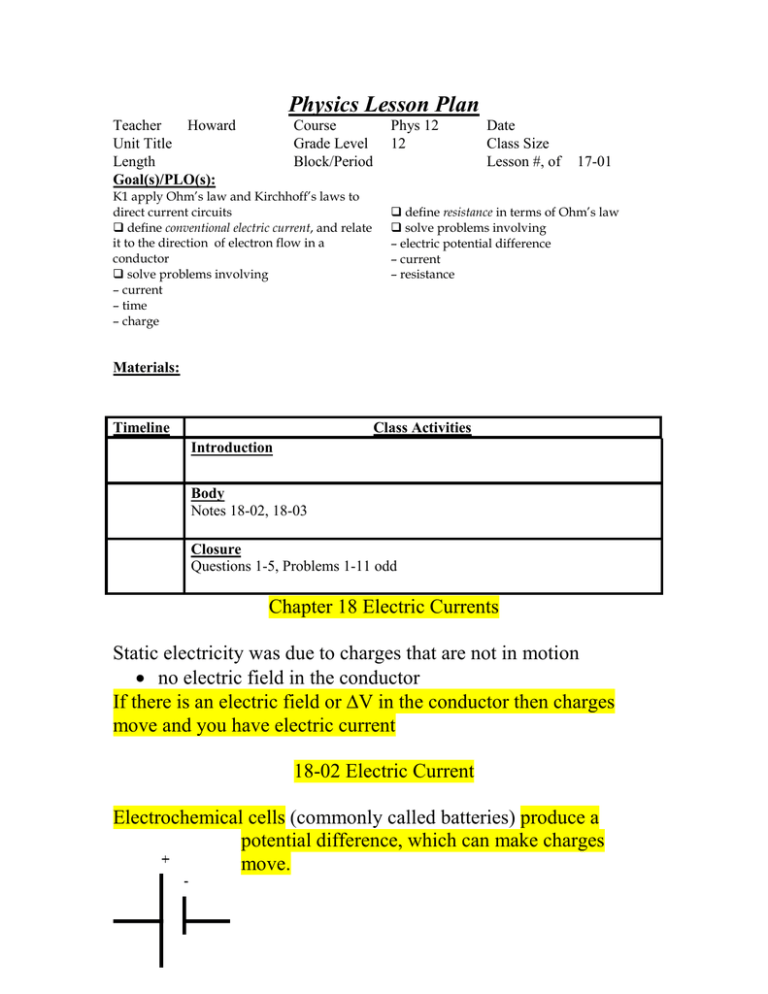
Physics Lesson Plan Teacher Howard Unit Title Length Goal(s)/PLO(s): Course Grade Level Block/Period K1 apply Ohm’s law and Kirchhoff’s laws to direct current circuits define conventional electric current, and relate it to the direction of electron flow in a conductor solve problems involving – current – time – charge Phys 12 12 Date Class Size Lesson #, of 17-01 define resistance in terms of Ohm’s law solve problems involving – electric potential difference – current – resistance Materials: Timeline Class Activities Introduction Body Notes 18-02, 18-03 Closure Questions 1-5, Problems 1-11 odd Chapter 18 Electric Currents Static electricity was due to charges that are not in motion • no electric field in the conductor If there is an electric field or ∆V in the conductor then charges move and you have electric current 18-02 Electric Current Electrochemical cells (commonly called batteries) produce a potential difference, which can make charges move. • If there is a continuous path connecting the terminals of a battery then you have a circuit along which electrons can flow • circuit-construction-kit-dc_en.jar Electric current The net amount of charge that passes through a conductor at any location during time t Current is measured in Coulombs per second or Ampere . Current can only flow in a complete or closed circuit. • If there is a break in the circuit it is called an open circuit If a circuit has only one path for the current to flow then the current is the same at all points. (simulation) • Charge can’t appear or disappear Example 18-1 and 18-2 In many real circuits wires are connected to a common conductor to provide continuity. • Ground o Not necessarily the ground (earth) When wires are connected to both terminals of a battery the potential difference sets up a field in the conductor parallel to the conductor causing electrons to flow from the negative terminal to the positive terminal. • Conventional current was named before the charge of the moving component of current was established o Flows from the positive terminal to the negative terminal 18-03 Ohm’s Law: Resistance and Resistors The current that flows through a wire is proportional to the potential difference applied to it’s ends ohms-law_en.jar Think of water flowing (I) through a pipe being pulled by gravity (V). • Steeper incline (more V) = more flow (more I) The exact current also depends on the width of the pipe (resistance of the wire R) Ohm’s Law Not all materials obey Ohm’s Law. Example 18-3 All electric devices offer resistance to the flow of current. • The wires’ resistance is usually low compared to the devices Resistors • Devices used to control the amount of current • circuit-construction-kit-dc_en.jar See the code on page 499 Example 18-4 Electric potential decreases as current flows through a resistor • potential drop • voltage drop Notes: 1. batteries do not provide constant current but (approximately) constant potential difference a. source of voltage b. External to (independent of) devices in the circuit 2. Current passes through a wire or device a. Magnitude depends on the device’s resistance b. Resistance is a property of the device 3. Current is not a vector even though it has a direction of flow a. The wires can turn corners without changing the direction of the current b. Conventional current flows from high potential (+) to low potential (-) c. The amount of current/charge is conserved and the amount entering one end of a device leaves the other end. Questions 1-5, Problems 1-9 odd






